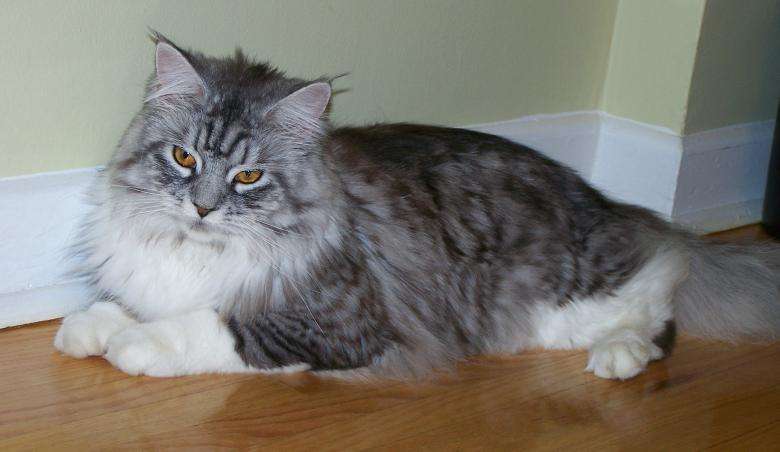SCORES & OUTDOORS: The Maine “gentle giant”
 by Roland D. Hallee
by Roland D. Hallee
Recently, my daughter and one of my granddaughters have expressed an interest in bringing home a Maine coon cat. I’ve heard a lot about coon cats, but what makes them so different, and their size.
The Maine Coon is a large domesticated cat breed. One of the oldest natural breeds in North America, the breed originated in the U.S. state of Maine, where it is the official state cat.
The Maine Coon is commonly referred to as “the gentle giant.” The Maine Coon is predominantly known for its size and dense coat of fur which helps it survive in the harsh climate of Maine. The Maine Coon is often cited as having the characteristics of a dog.
The Maine Coon has a distinctive physical appearance and valuable hunting skills. The breed was popular in cat shows in the late 19th century, but its existence became threatened when long-haired breeds from overseas were introduced in the early 20th century. The Maine Coon has since made a comeback, in 2023 the Maine Coon overtook the Exotic, becoming the second most popular pedigree cat breed in the world.
However, their lineage is surrounded by mystery, folk tales, and myths. One myth claims the Maine Coon cat is a hybrid with another animal species, such as the raccoon or bobcat. The second myth states the cats are descendants of Viking ship’s cats, known today as the Norwegian Forest cats. A third story involves Marie Antoinette, the Queen of France, who was executed in 1793. The story goes that before her death, Antoinette attempted to escape France with the help of Captain Samuel Clough. She loaded Clough’s ship with her most prized possessions, including six of her favorite Turkish Angora or possibly Siberian cats. Although she did not make it to the United States, all of her pets managed to reach the shore of Wiscasset, safely, where they bred with other short-haired breeds and developed into the modern breed.
These myths and theories have long speculated that the long-haired Maine Coon cat has to be related to other long-haired breeds, due to their similarities in the observable characteristics or traits in an individual based on the expression of their genes. For the Maine Coon in particular, that it is descended from the Norwegian or Siberian Forest cat, brought to New England by settlers or Vikings. Studies showed the Maine Coon belongs to the Western European cat branch, but forms the closest relationship with the random-bred cat population in the Northeastern U.S. (New York region). This Western European branch contains the Norwegian and Siberian Forest cat.
Maine Coons are descendants of cats brought to New England by Puritan settlers in the 1600-1700s.
The first mention of Maine Coon cats in a literary work was in 1861, in Frances Simpson’s The Book of the Cat (1903). F.R. Pierce, who owned several Maine Coons, wrote a chapter about the breed. During the late 1860s, farmers located in Maine told stories about their cats and held the “Maine State Champion Coon Cat” contest at the Skowhegan State Fair.
In the early 20th century, the Maine Coon’s popularity began to decline with the introduction of other long-haired breeds, such as the Persian, which originated in the Middle East. The last recorded win by a Maine Coon in a national cat show for over 40 years was in 1911 at a show in Portland, Oregon. The breed was rarely seen after that. The decline was so severe the breed was declared extinct in the 1950s, although this declaration was considered to be exaggerated and reported prematurely at the time.
Maine Coons have several physical adaptations for survival in harsh winter climates. Their dense water-resistant fur is longer and shaggier on their underside and rear for extra protection when they are walking or sitting on top of wet surfaces of snow or ice. Their long and bushy raccoon-like tail is resistant to sinking in snow, and can be curled around their face and shoulders for warmth and protection from wind and blowing snow. It can even be curled around their backside like an insulated seat cushion when sitting down on a frozen surface.
Large paws help with walking on snow and are often compared to snowshoes. Long tufts of fur growing between their toes help keep the toes warm and further aid walking on snow by giving the paws additional structure without significant extra weight. Heavily furred ears with extra long tufts of fur growing from inside can keep warm more easily.
Maine Coons can have any colors that other cats have. Colors indicating crossbreeding.
In 2010, the Guinness World Records accepted a male purebred Maine Coon named “Stewie” as the “Longest Cat”, measuring 48.5 inches from the tip of his nose to the tip of his tail. Stewie died on February 4, 2013, from cancer at his home in Reno, Nevada, at age 8.
The median life expectancy of a Maine Coon is 12.5 years.
Roland’s trivia question of the week:
What is the Philadelphia Eagles record in the Super Bowl?
Responsible journalism is hard work!
It is also expensive!
If you enjoy reading The Town Line and the good news we bring you each week, would you consider a donation to help us continue the work we’re doing?
The Town Line is a 501(c)(3) nonprofit private foundation, and all donations are tax deductible under the Internal Revenue Service code.
To help, please visit our online donation page or mail a check payable to The Town Line, PO Box 89, South China, ME 04358. Your contribution is appreciated!



Leave a Reply
Want to join the discussion?Feel free to contribute!